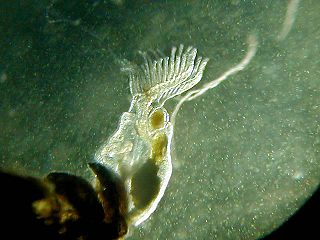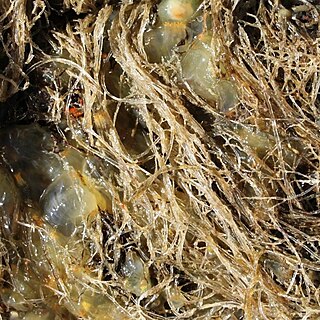
Bryozoa are a phylum of simple, aquatic invertebrate animals, nearly all living in sedentary colonies. Typically about 0.5 millimetres long, they have a special feeding structure called a lophophore, a "crown" of tentacles used for filter feeding. Most marine bryozoans live in tropical waters, but a few are found in oceanic trenches and polar waters. The bryozoans are classified as the marine bryozoans (Stenolaemata), freshwater bryozoans (Phylactolaemata), and mostly-marine bryozoans (Gymnolaemata), a few members of which prefer brackish water. 5,869 living species are known. Originally all of the crown group Bryozoa were colonial, but as an adaptation to a mesopsammal life or to deep‐sea habitats, secondarily solitary forms have since evolved. Solitary species has been described in four genera; Aethozooides, Aethozoon, Franzenella and Monobryozoon). The latter having a statocyst‐like organ with a supposed excretory function.

Cheilostomatida, also called Cheilostomata, is an order of Bryozoa in the class Gymnolaemata.

Membranipora membranacea is a very widely distributed species of marine bryozoan known from the Atlantic and Pacific Oceans, usually in temperate zone environments. This bryozoan is a colonial organism characterized by a thin, mat-like encrustation, white to gray in color. It may be known colloquially as the coffin box, sea-mat or lacy crust bryozoan and is often abundantly found encrusting seaweeds, particularly kelps.

Cyclostomatida, or cyclostomata, are an ancient order of stenolaemate bryozoans which first appeared in the Lower Ordovician. It consists of 7+ suborders, 59+ families, 373+ genera, and 666+ species. The cyclostome bryozoans were dominant in the Mesozoic; since that era, they have decreased. Currently, cyclostomes seldom constitute more than 20% of the species recorded in regional bryozoan faunas.

A zooid or zoöid is a single animal that is part of a colonial animal. This lifestyle has been adopted by animals from separate unrelated taxa. Zooids are multicellular; their structure is similar to that of other solitary animals. The zooids can either be directly connected by tissue or share a common exoskeleton. The colonial organism as a whole is called a zoon, plural zoa.
In the bryozoan order Cheilostomatida, the operculum is a calcareous or chitinous lid-like structure that protects the opening through which the polypide protrudes.

Phylactolaemata is a class of the phylum Bryozoa whose members live only in freshwater environments. Like all bryozoans, they filter feed by means of an extensible "crown" of ciliated tentacles called a lophophore, and like nearly all bryozoans, they live in colonies, each of which consists of clones of the founding member. Unlike those of some marine bryozoans, phylactolaemate colonies consist of only one type of zooid, the feeding forms known as autozooids. These are supported by an unmineralized "exoskeleton" made of gelatinous material or protein, secreted by the zooids. The class contains only one extant order, Plumatellida.
Cauloramphus disjunctus is a species of small colonial bryozoan found encrusting rocks in shallow parts of the sea near Japan. Fossils of this species have been found that date back a million years.
Amathia vidovici is a species of colonial bryozoans with a tree-like structure. It is found in shallow waters over a wide geographical range, being found in both the Atlantic and Pacific Oceans and adjoining seas.
Fenestrata is an extinct order of bryozoan, dating from the Upper Arenig. Most fenestrate bryozoans formed net-like colonies, often in funnel- or fan-shaped forms, with a single layer of zooids facing one direction. The colony shape served as a filter-feeding apparatus that water currents flowed through, with autozooecial apertures only on the side of the colony facing into the current. This colony structure was vulnerable to predators, so some fenestrate bryozoans produced skeletal superstructures, likely to strengthen or protect the colony, and others had protective spines surrounding their autozooecial apertures.

Amathia verticillata, commonly known as the spaghetti bryozoan, is a species of colonial bryozoans with a bush-like structure. It is found in shallow temperate and warm waters in the western Atlantic Ocean and the Caribbean Sea and has spread worldwide as a fouling organism. It is regarded as an invasive species in some countries.

Conopeum seurati is a species of colonial bryozoan in the order Cheilostomatida. It is native to the northeastern Atlantic Ocean, the North Sea and the Mediterranean Sea. This species has been introduced to New Zealand and Florida.

Bugula neritina is a cryptic species complex of sessile marine animal in the genus Bugula. It has a practically cosmopolitan distribution, being found in temperate and tropical waters around the world, and it has become an invasive species in numerous locations. It is often found in hard substrates, such as rocks, shells, pillars and ship hulls, where it can form dense mats, contributing to biofouling. B. neritina is of biomedical interest because it harbors a bacterial symbiont that produces a group of bioactive compounds with potential applications in the treatment of numerous diseases.

Watersipora subtorquata, commonly known as the red-rust bryozoan, is a species of colonial bryozoan in the family Watersiporidae. It is unclear from where it originated but it is now present in many warm-water coastal regions throughout the world, and has become invasive on the west coast of North America and in Australia and New Zealand.

Catenicella is a genus of marine bryozoans belonging to the family Catenicellidae. Bryozoans are colonial animals that live in aquatic environments, and Catenicella is no exception. Members of this genus are found in oceans around the world, with a particularly high diversity in the Arctic and Antarctic regions.

Beania magellanica is a species of colonial bryozoan in the family Beaniidae. It has a cosmopolitan distribution, occurring in shallow waters in the Atlantic and Pacific Oceans and in Antarctica.

Electra posidoniae is a species of bryozoan in the family Electridae. It is endemic to the Mediterranean Sea, and is commonly known as the Neptune-grass bryozoan because it is exclusively found growing on seagrasses, usually on Neptune grass, but occasionally on eelgrass.
Callopora lineata is a species of colonial bryozoan in the family Calloporidae. It is found on rocky shores in the Atlantic Ocean and the Mediterranean Sea.

Crisularia plumosa is a species of bryozoan belonging to the family Bugulidae, commonly known as the feather bryozoan. It is native to the Atlantic Ocean.
Lichenalia is an extinct genus of cystoporate bryozoan belonging to the family Rhinoporidae. It is known from the Upper Ordovician to the Middle Silurian periods, which spanned from approximately 460 to 430 million years ago. The genus had a cosmopolitan distribution, with fossil specimens found in various regions of the world, including North America, Europe, and Asia.













